Posted: 07 Aug 15
Edited: 08 Aug 15
Abstract
The goal of this study was to examine the impact of particular tampers on espresso extraction. Our main objective metric was TDS assessed via two refractometers (VST LAB Coffee III and Atago PAL-COFFEE). Four different tampers were used (Pullman BigStep, Pergtamp, Eazytamp, and La Marzocco), with 10 shots per tamper. A significant difference was found between tampers, with the La Marzocco tamper yielding significantly lower TDS and extraction yield. No difference was found between the TDS measurements of the VST and Atago.
Bottom line
Based on the tampers we tested, only the La Marzocco tamper had a significant (albeit, negative) impact on TDS and extraction yield. All others were statistically not different. Measurements between the VST and Atago were also statistically not different.
Disclosures
We have no vested interest in any of the products being used for this experiment.
Authors
Jeremy and Joe
Introduction
Espresso extraction consists of driving hot water through a packed bed of ground coffee with a pressure gradient. Many variables can affect this process such as temperature of the water, pressure by which water is applied to the bed of coffee, extraction time, and flow rate. The process of tamping the bed of coffee in a portafilter, it is thought, allows the operator to impact the permeability characteristics of the coffee. As permeability relates to particle size distribution and packing structure, tamping may allow the opportunity to influence the latter. How hard one tamps affects the coffee bed’s bulk density. Our previous post demonstrated, within a range of 5-20 kg applied tamping force, there was no discernible difference in TDS or brewing time. However, within that force range, there may be other opportunities for tamping to impact mass transfer, as bed bulk density has been shown to have a significant impact on overall permeability (King, 2008; Navarini et al., 2009) and dynamics such as bed tortuosity and swelling of the cellulose matrix, as described by Mateus & Rouvet (2007), may occur.
The two main hypotheses were 1) the tamper used would have a significant effect on TDS and 2) the Atago PAL-COFFEE and VST LAB III would give significantly different TDS readings for the same sample of coffee.
Methods
The coffee used for the experiment was MC Euro Classic Espresso Blend. Coffee was rested for 10 days before use. The same batch of roasted coffee was used for the entire experiment.
Equipment used:
- La Marzocco (LM) GS/3 MP (mechanical paddle), single group fitted with 0.6mm restrictor and a naked portafilter with the 20g VST basket filter, set at 9 bar water pressure (verified with a Scace II); brewing temperature 92.5 degrees C regulated with a PID on board
- Water filter used for the experiment was Brita Purity C150 Quell ST
- Victoria Arduino Mythos One coffee grinder
- Two scales (Ohaus to measure the dry coffee dose; AWS to measure the beverage mass)
- Pen and paper to record values
- Pair of scissors
- Infra red thermometer
- 10 (for each condition) empty ramequin bowl for measuring the mass of the shot
- 10 (for each each condition) ceramic/glass cups for TDS measurement
- Pullman BigStep Flat 58.60 mm
- Pergtamp Flat 58.50 mm
- Eazytamp 5 Star Pro Flat 58.0 mm
- La Marzocco Flat (but rounded edge) 58.0 mm (comes with some commercial La Marzocco machines)
- Atago PAL-COFFEE refractometer
- VST LAB III 4th Generation refractometer
- Distilled water
- Alcohol pads
- PipetteServiettes
Experiment was carried out over 5 hours. The conditions with the grinder and espresso machine were constant for all conditions. Four testing stations were set up (80 ceramic bowls needed for the whole experiment) in order to avoid any disruption to the experiment’s routine. The grinder blades were warmed up by grinding 500g of coffee beans. The room temperature was controlled with air conditioning at approximately 22 degrees Celsius for the duration of the experiment. Multiple experimenters were used for the data collection and analysis, with only tracking labels used for data recording and analysis. Physical walls were placed between the experimenter preparing the shots and the experimenter recording the TDS. Labels were matched via a key to reveal which tamper went with each set of data only after all analyses were complete.
A brew ratio of 1g coffee to 2g brew weight was used (i.e., 20g dose for 40g final beverage mass). Because TDS is most strongly correlated with quantity of beverage, shots were all pulled to a consistent weight. Time to reach this weight was recorded, giving us a metric of flow rate (weight/time). The grinder was dialed in using 15 kg tamping pressure with a target of 40g final beverage mass in around 40 seconds. No grind adjustments were made for the entirety of the experiment. The pre-experiment dialing in of the grinder was performed using the Pergtamp. Included here are videos from shots with the other tampers used (BigStep, Eazytamp, and La Marzocco).
Four different tampers were used, with 10 shots per each tamper. One shot with each tamper was performed in a round (10 total rounds). Each shot was tamped in a consistent manner. Order of tamper used per round was randomized, as was the order of the sample being placed into the refractometer. Tamp levelness was checked using a micron measurement tool as demonstrated here. By placing the measurement probe to the coffee bed surface and moving it within the basket, we were able to assess any possible pitch or roll (i.e., unlevelness).
Zeroing preparation of the refractometers was performed identically for all conditions.
- Prior to all measurements, the refractometers were set at room temperature together with the distilled water (a common practice we use).
- All refractometers were zeroed and cleaned prior to the coffee extraction.
- The water temperature for zeroing was between 15-30°C (as recommended by VST).
Filtering procedure:
- For each shot, we allowed the espresso to cool for 1 minute and the sample was stirred for 5 seconds.
- For each shot, the coffee crema was skimmed with a clean spoon prior to every reading.
- For each espresso, 4ml of espresso was drawn up using a pipette and slowly dispensing it into a clean ceramic cup. The sample was then given approximately 45 seconds to cool down. Filters were not used for this experiment, as our other experiment demonstrated that they do not have a significant effect on the devices’ TDS readings for espresso.
Sampling procedure:
With a clean pipette, we drew a sample large enough to dispense into both refractometers. This sample was transferred to a clean, dry cup and allowed to cool for an additional 30 seconds (the temperature of the sample was checked with the infra-red thermometer). Another fresh pipette was then used to siphon the cooled espresso sample and transfer it to the refractometer wells. The coffee sample was allowed 25 seconds to equilibrate in the well of the refractometer before recording.
Results
A mixed design analysis approach was used on the data from this study (using R 3.1.1). As per our usual protocols, data was analyzed in a de-identified manner (using labels matched to a key after all analyses were completed) by an individual not involved in the data collection. Ten samples per tamper were measured (40 total measurements for each refractometer). The two between variables were device (Atago, VST Lab III) and tamper (La Marzocco, BigStep, Pergtamp, and Eazytamp). Order of the samples being placed on the refractometers was pseudo-randomised to ensure a balanced order, as was order tampers were used in a single round.
Data was first assessed to ensure it does not violate assumptions for an analysis of variance (ANOVA) or multiple linear regression analysis. Further, brew weights between tamper conditions were checked to ensure they did not vary significantly via t-tests (p ≥ 0.11 for all). An initial two-way ANOVA was run to determine the impact of tamper and refractometer device on TDS, as well as assess for any systematic interaction effects. Tamper was shown to have a significant impact on TDS (F(3,72) = 6.40, p = 0.00) but refractometer was not (p = 0.91), nor was there a significant interaction between device and tamper (p = 0.99). TDS measurements were then collapsed into a single variable for further analyses.
Due to their correlation (high collinearity), brew weight and time were centered, as described in our previous post. A hierarchical multiple regression was then run using one to four predictors (brew weight, brew time, round, and tamper, respectively) for TDS. The only significant predictor was that of tamper, so a one-way ANOVA was performed between tamper and TDS (F(3,36) = 3.24, p = 0.03). Post-hoc contrasts revealed the only significant tamper condition was that of the La Marzocco, with a significantly reduced TDS.
Extraction yield, which provides a control for brew weight as it is calculated based in part with the variable, was then compared. We remind you to not concern yourself too much with the absolute numbers shown here, as we could easily use another formula and alter all values around 1.2 or more (through the manipulation of assumed variable values). For the purposes here, all values were held constant except for those we quantified (i.e., dose, brew weight, TDS). An ANOVA of tamper and extraction yield revealed a significant effect (F(3,36) = 3.69, p = 0.02). Average extraction yield values for each tamper were: 21.5% +/- 0.46 (La Marzocco), 22.3% +/- 0.80 (Eazytamp), 22.1% +/- 0.48 (Pergtamp), and 22.0% +/- 0.37 (BigStep). Three of the tampers led to significantly greater extraction yield compared to the La Marzocco (all p ≤ 0.01). The three tampers (Eazytamp, Pergtamp, BigStep) did not differ significantly from each other (all p ≥ 0.19). We then plotted the extraction yield values (reminder, the only significant difference is a reduced EY with the La Marzocco tamper):
To explore these variables a bit more, we did a 3D scatterplot to examine the relationship between extraction yield, TDS, and brew weight. With just visual inspection, it would appear you can get a high extraction yield at a variety of brew weights (a great explanation on how these variables relate can be found here).
(Raw data can be downloaded in a tab delimited text file here. As always, while we offer the data for your personal use, we kindly ask that you send a message to socraticcoffee@gmail.com before posting or presenting it in any public forum and attach appropriate acknowledgement.)
Conclusions
Overall, the VST and Atago devices performed comparably–the readings from the different devices are statistically indistinguishable. Which tamper was used did have a significant impact on espresso TDS, with the La Marzocco tamper having significantly lower TDS readings. Two of the three tampers that had comparable TDS have slightly enlarged surfaces (BigStep and Pergtamp). The other, Eazytamp, has a lip which catches the top of the portafilter basket and ensures level and uniform compression of the coffee bed, but it maintains a 58.0 mm diameter surface, so we cannot attribute the results simply to larger diameter tamper base/head. [Edit: 08 Aug 15] One possibility is that the La Marzocco tamper base is not completely flat nor consisting of a sharp edge. [/Edit] Otherwise, we were not able to determine a relationship between a particular tamper and its influence on TDS (or subsequent extraction yield). The three tampers with a similar extraction yield had an average increase over the La Marzocco of 0.6 (i.e., similar three at 22.1% – LM at 21.5%). Individually, the average extraction yield increases over the La Marzocco tamper were 0.8 (Eazytamper), 0.6 (Pergtamp), and 0.5 (BigStep); again, though, these three tampers did not differ significantly from one another, only from the La Marzocco.
It may be that other variables not quantified here were significantly affected. Our measurements captured the total dissolved solids content of the shot, as well as a rate metric (brew weight/total brew time), but it is possible that tamper type affects aspects of the extraction that we did not assess (e.g., characteristics of particular compound extraction such as lipids).
References
King, WD. (2008). The physics of a stove-top espresso machine. Am J Phys. 76 (6), 558.
Mateus, M., Rouvet, M. (2007). Interactions of water with roasted and ground coffee in the wetting process investigated by a combination of physical determinations. J Agric Chem, 55, 2979-2984.
Navarini, L., Nobile, E., Pinto, F., Scheri, A., Suggi-liverani, F. (2009). Experimental investigation of steam pressure coffee extraction in a stove-top coffee maker. Appli Therm Eng, 29 (5-6), 998-1004.
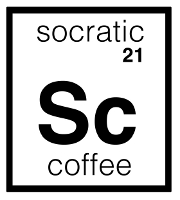
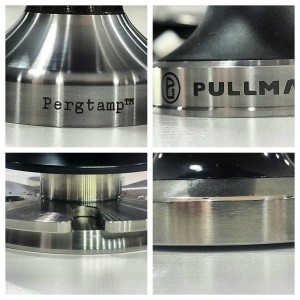
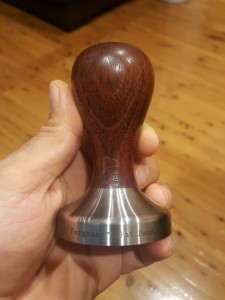
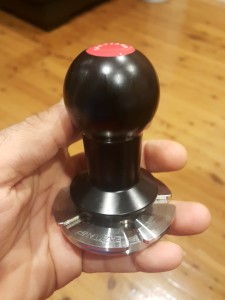
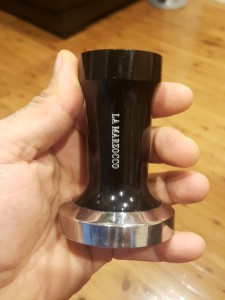
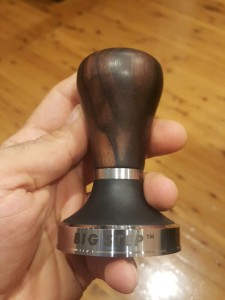
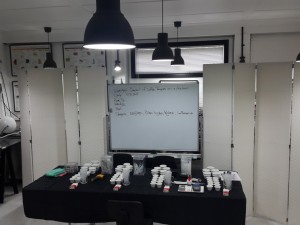
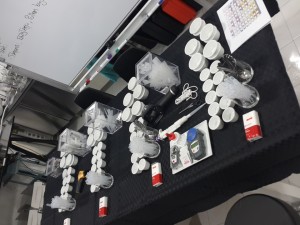
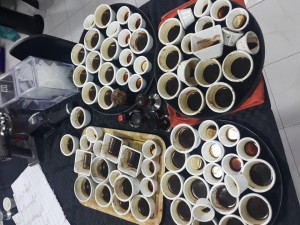
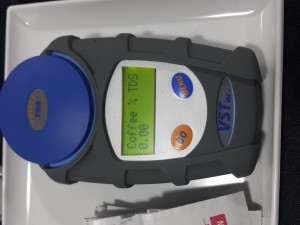
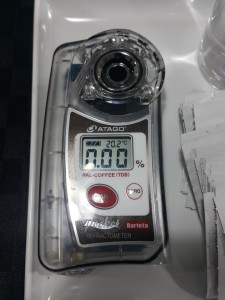
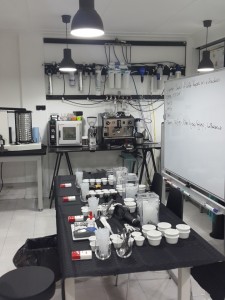
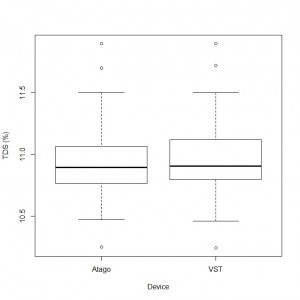
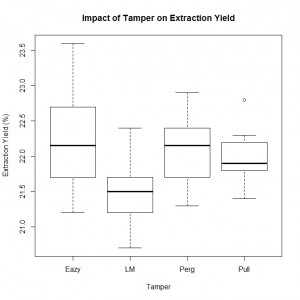

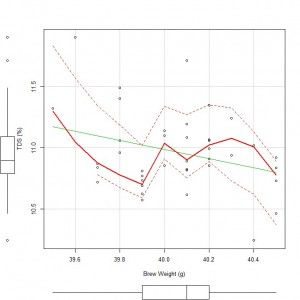
coffeecircus
Thank you for your result. Now we know what, but it would be great to know also why. What do you think is the reason of the lower extraction on the LM tamper?
Jeremy
It’s not really clear why the LM tamper came out worse — it lacked the larger diameter head of the Pergtamp and BigStep as well as the self-leveling flange of the Eazytamp. It’s interesting to note that the Eazytamp has a 58.0 mm diameter and was equally as effective as the larger diameter tampers. Knowing “why” is no easy process, as Corrochano et al. (2015) describe in their paper “A new methodology to estimate the steady-state permeability of roast and ground coffee in packed beds”!
Alex
I’m not sure if this is new, but the Eazytamp now comes in a 58.4 base (I think they’ll do custom sizes too), I wonder if this would be enough to statistically separate it from the other PergTamp and the BigStep.
Jeremy
Never know until someone tests it! We may return to the tamper topic at some point, since there have been a lot of new devices coming out lately.
Jeremy
Joe
Hi,
It could be possibly because of the base shape. The LM tamper’s base isn’t 100% flat.
The difference between the Eazytamp 58mm (straight base) and the LM 58mm is the base.
Eazytamp, Pergtamp, Pullman Bigstep all stand flat straight while The LM tamper wobbles on a straight surface
Joe
Joe
Just uploaded a photo of the various bases used
Mark
Hi Jeremy,
Is there a difference in the edge of the tamper face between the LM & Eazytamp (e.g. radiused edge)?
Regards, Mark.
Joe
Hi Mark,
Please check my reply to coffeecircus ,hopefully when we get a chance we will upload a video on YouTube showing the bases of the four tampers used in the experiment.
Joe
Jeremy
Hi Mark — there is and we’ve altered the write-up to reflect that. Thanks!
Joe
Just uploaded a photo of the various bases used
Mat
Really interesting guys.
I’m not surprised in your results at all, I saw similar between the Pergtamp and a 58.35 Reg Barber.
Which leads me to two questions;
a) Given that the LM and Eazytamp performed very differently despite the sames diameter, is it something in the construction and quality of tamp(due to the leveling collar) that makes accounts for this? In other words, is quality of tamp more important than size?
b) For less well made tamps is there a limiting size above which we see this diffecence in tds mitigated. For example, the 58mm LM and a 58.3mm Reg Barber may perform differently and yet both have rounded edges to the base. at what point does size compensate for quality?
Jeremy
Hi Mat,
All great questions that we’d need to test! The biggest difference between the tampers we tested seems to be, as you stated, the rounded edge along the base–diameter seemed to be less (not?) important. However, we did not set out to systematically assess this attribute specifically, so it’s hard to say for certain since there was not a tamper with slightly larger than 58mm diameter and rounded edge (like you mentioned).
Jeremy
Dennis
I think you should have compared some different varieties of tampers. I thought its known by now that extraction yield is influenced by two factors: base shape – convex or flat and edge design – sharp or beveled. Meaning, flat base with sharp edge extracts better.
You choose all tampers with the sharp edge and flat base EXCEPT the La Marzocco tamper which is NOT flat base rather its convex and it does NOT have a sharp edge. So its not surprising that flat tampers with sharp edge extract about the same while convex tamper with the beveled edge extracts the least…
Jeremy
Hi Dennis,
Thanks for the comment — hopefully we can do additional variations of this experiment in the future, assessing the impact of other tamper-related variables on extraction. For many things, we’re not really sure what “is known” in the coffee community, as the information is most often NOT acquired through ANY sort of rigorous, systematic testing. Typically, what “is known” seems to be based on a pseudo-science explanation of how someone intrinsically believes the numerous variables of coffee interact. In academic circles, this would be referred to as naïve physics/folk physics. More often than not, it seems people are really espousing their subjective perceptions, gathered through acquired coincidental observation, which is very useful to create theories and hypotheses for testing, but is far from definitive data. And much of the objective data that does get touted lacks solid controls/methodological design, proper analysis, and draws bad conclusions from weak evidence.
One of the goals at Socratic Coffee is to start from a more tabula rasa position, testing things for ourselves using established scientific protocols and analyses similar to what we do in our professional, day-time research endeavors. To paraphrase a quote often attributed to Socrates, we know that we know nothing! We were also told “everyone knows [refractometer X] is better than all others”; however, repeated empirical testing with appropriate experimental design has demonstrated that is not the case.
All that to say, if you are aware of strong objective empirical evidence demonstrating the points you made, please pass them along!
Thanks,
Jeremy
Dennis
Jeremy, I did lot of testing with VST refractometer to asses which tamper base gives better extraction yield and on all my tests the flat base outperformed convex or semi convex base by about 1% larger extraction yield. Both bases have rounded corner.
I have also observed that tamper edge, corner, influences the extraction yield, again this is measured with VST refractometer. Given same base shape, sharp tamper edge outperforms rounded corner tampers.
So the worst combination as far as extraction yield goes is convex tamper bottom with rounded edge.
All testing performed with VST 18g basket using 18g of coffee…
Jeremy
Hi Dennis,
Thanks for the info. I think these are things we could try to replicate at some point–manipulating base shape and base edge. Though our result was significant, our average extraction yield difference was only 0.6 between flat-bottom tampers with a sharp edge and the tamper with a rounded edge and convex/semi-convex bottom. Based on our data, I’m a bit skeptical as to whether or not the design of a tamper itself can reliably impact the extraction yield of espresso by 1.0% or more. When I say 1% increase in extraction yield, I am saying 1% increase in the actual calculated extraction yield, or overall percentage of solubles drawn out of the ground coffee–it can get a little confusing, as 0.6% increase in extraction yield, for our study, was technically a 2.7% increase in relative “brew efficiency” compared to the lesser extraction yield (i.e., 0.6/21.5). I sometimes wonder if people get those things mixed up.
Jeremy
Mark
Hey Jeremy, Like youl site and love that you are testing some of the so called “rules” of espresso. I get less spritzers form my Concept Art curved base tamper than the high dollar, flat based, tight fitting tamper. I purchased this Concept Art tamper so my wife could get a consistent pressure tamp. My theory on the less spritzers is that since it does not fit as tight, it allows more nutation that the other tamper.
Miss seeing you at Brown.
Mark
Jeremy
Hey Mark,
Thanks for the message! While I like the concept, exploring the impact of nutation is tricky–would need to figure out how we can do it in a controlled, repeatable way. I miss you and the crew at Brown! I’m sure we’ll be back down that way at some point…
Jeremy
Mads
Hi Jeremy and Joe! It’s very interesting to follow you on instagram 🙂
Have you guys tried to measure the extraction yield when using a classic convex tamper like the Reg barber?
Kind Regards
Mads
Joe
Hi Mads,
Thanks for the message and glad to hear you are enjoying our instagram account.
As for the convex tamper, we are planning to test more coffee tampers and basket filters in the near future so stay tuned!
James Craig
I am a roaster and was just wondering which coffee and roast degree was used here. This would be interesting to know, and i wonder if different tampers produce different results over different roast levels?
Joe
Hi James — that’s an interesting question. We can’t rule that out as a possibility. Level of roast, density of bean, etc., more than likely affect aspects about how the bean fractures during grinding, which could impact particle-to-particle interfaces. So it may be that a different style tamper works most effectively for a different coffee and/or roast. Seems unlikely, to us, but maybe!
Joe
Alfio
Superb work 🙂 But by my experience there is something more: the impact of Tamper is magnify by the fine of the coffee ground,by the freshness of coffee and by humidity.
Jeremy
Thanks, Alfio! No doubt there are some fairly complex interactions among many variables, as you mentioned. As with anything in science, it’s all about tackling something complex piece-by-piece.
Jeremy
Adam
Did you guys consider leaving time as a constant and adjusting grind size to account for that for each different tamper? What effect do you think that would have?
Jeremy
Hey Adam,
Thanks for the comment! Because extraction yield was our main metric, and we know that beverage mass is far-and-away the most influential component of that, we chose to keep final mass as constant as possible. If we had held time constant, we would have had variable extraction yields due to changes in beverage mass, grind size/particle distribution, and tamper. And that would have made the results much more difficult to interpret as we attempt to disentangle which bit of variance goes with which independent variable. I would imagine that grind setting would become a big contributor at that point, probably overshadowing anything caused by the tampers!
What are your thoughts as to why a time constant would be a good approach?
Jeremy
Jason
Thanks for the good works.
I have one question. Since the extraction weight, tamp level and grind size were kept constant, why the extraction time can vary up as much as 10 seconds?
Jeremy
Hi Jason,
To be honest, we just don’t know… and that’s how science goes sometimes! Even after controlling for everything you can think of, differences may emerge in unexpected areas. If we had to hypothesize, it may be some randomness related to a physics phenomenon known as “jamming”. The interface of small particles and their influence on the greater system (i.e., espresso extraction) can be complex and is something we are currently looking to explore (though, we, admittedly, don’t have the lab equipment or expertise to do so–but we’re in contact with someone who does!). Axial compression of a VERY heterogeneous mixture (in size AND shape) comprised of permeable, semi-brittle particles leads to an unlimited number of interesting configurations which create varying paths and resistance for the water. The bigger point is that the time did not vary significantly between any of the tampers, suggesting this variability in shot time is part of the randomness in the world that we manage through strict methodological procedures (e.g., multiple investigator blinding, randomization of order). Had we seen something systematic, that might be cause for concern. Fortunately, we did not.
Jeremy
mdg
very interesting that there’s a significant difference in means between LM and the eazy, but not between the perg, pull, and eazy together, especially considering that the eazy had the largest SD (~0.8) and the pull the smallest (~0.37). Doing an ANOVA between the latter three means using the data provided, p=0.62 that there is no significant difference…this subject definitely needs more investigation. Thanks for your transparency!
Gaby
Hi there,
Couldn’t help noticing an inverse correlation between the size of the Tamper Base and the standard deviation of the Extraction Yield for the flat based Tampers.
May suggest that tamping closer to the edges of the basket results in more consistency in extraction yield. Makes sense in some ways if one assumes that part of the variation may be caused by some degree of channeling at the basket wall interface with the coffee pug and that the better and more evenly the coffee is tamped at the boundary with the basket walls, relative to the rest of the coffee pug, the less room there is for micro channeling at the boundary and hence the more consistent the yield extraction. Just a thought..
Gaby
Jeremy
Hi Gaby,
There were some potentially interesting findings that may warrant further investigation at some point. A methodical study of tamp bottom curvature, edge sharpness, and total surface area would be an ideal. Always plenty of things to study, never enough time! Maybe you could study it and let us know what you find out?
Jeremy
Gaby
Thanks Jeremy, I will do my best and let you know if I come up with anything worthwhile.
For now I am just trying to learn how to make better tasting coffee. Your article has been most informative and took me back to my Uni days and extracting tar from coal in the in the ChemEng lab.
Best Regards,
Gaby
Faisal Mushtaq
Hi
I want to buy some pieces of refractometer for my newly opened unit .could you please provide me information that where I can get this .
David Durkee
Hi,
Thank you for publishing your experiment. I find the results of interest. One question please — How did you control for even distribution of the grounds in the baskets?
Thank you,
David Durkee
Jeremy
Hi David,
The distribution of grounds in the baskets was consistent (well, consistently random) for all conditions. Our typical approach is a single gentle tap, which we recently assessed against no tap and found no significant difference in extraction. Outside of that, there’s no concerted effort to spread the grounds, as you might do using a device such as the OCD. So, there was the randomness in the depositing of the grounds from the grinder itself. And any potential systematic effects in grinder depositing would be countered with the randomness in our tamper condition order.
Hope that answers your question.
Jeremy
Duke
Was this test done with or without preinfusion?
Jeremy
Without preinfusion. There could very well be an interaction between preinfusion and tamping, but that would require an additional set of experiments and some significant controls to appropriately tease apart (assuming there’s a relationship).